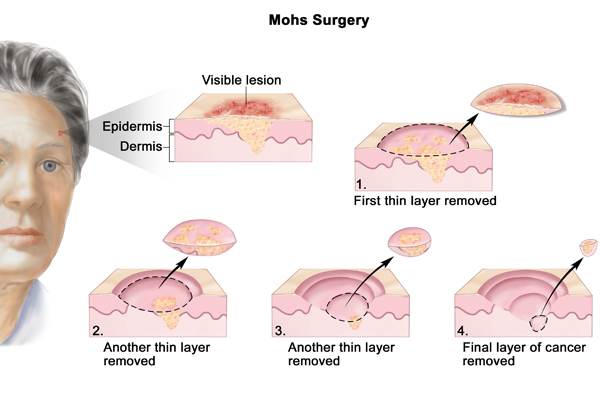BCC Surgical Treatment
Basal Cell Carcinoma (BCC) is the most common type of skin cancer, often caused by prolonged sun exposure. Surgery is the primary treatment option for most cases, aiming to completely remove the cancer while preserving as much healthy skin as possible.
Surgical Treatment Options for BCC
1. Excisional Surgery (Wide Local Excision)
- Procedure: The tumor is surgically removed with a margin of healthy tissue to prevent recurrence.
- Margin: Typically 4–5 mm of surrounding normal skin is excised.
- Best for: Small to moderate BCCs in low-risk areas.
- Healing: Sutures are placed, and healing takes a few weeks.
2. Mohs Micrographic Surgery
- Procedure: The tumor is removed layer by layer, and each layer is examined under a microscope until no cancer cells remain.
- Advantages: High cure rate (up to 99%) and minimal removal of healthy tissue.
- Best for:
- BCCs on the face, ears, nose, or eyelids.
- Large, recurrent, or aggressive tumors.
- Healing: May require sutures, skin grafts, or flaps depending on the wound size.
3. Curettage and Electrodessication (Scraping & Burning)
- Procedure: The tumor is scraped off with a curette, and the area is burned with an electric needle to destroy remaining cancer cells.
- Best for: Small, superficial BCCs on non-cosmetic areas.
- Healing: Heals as an open wound with minimal scarring.
- Recurrence Risk: Higher than excision or Mohs.
4. Cryosurgery (Freezing with Liquid Nitrogen)
- Procedure: Liquid nitrogen is applied to freeze and destroy cancer cells.
- Best for:
- Small, superficial BCCs in low-risk areas.
- Patients who cannot undergo surgery.
- Healing: The lesion forms a blister, then scabs over and falls off.
- Recurrence Risk: Moderate, may require multiple treatments.
5. Reconstructive Surgery (After Tumor Removal)
- If BCC removal leaves a large wound, reconstructive techniques such as:
- Skin grafts (taking skin from another part of the body)
- Flap surgery (repositioning nearby skin)
- Primary closure (directly stitching the skin edges together)
Post-Surgical Care & Follow-Up
✅ Wound Care: Keep the area clean and apply antibiotic ointment.
✅ Scar Management: Silicone gel, sunscreen, and massage may help.
✅ Regular Skin Checks: To monitor for recurrence or new BCCs.
✅ Sun Protection: Use sunscreen (SPF 30+), wear protective clothing, and avoid peak sun hours.



